New General Catalog Objects: NGC 1650 (original) (raw)
QuickLinks:
1650, 1651, 1652, 1653, 1654, 1655, 1656, 1657, 1658, 1659, 1660, 1661, 1662, 1663, 1664, 1665, 1666,
1667, 1668, 1669, 1670, 1671, 1672, 1673, 1674, 1675, 1676, 1677, 1678, 1679, 1680, 1681, 1682, 1683,
1684, 1685, 1686, 1687, 1688, 1689, 1690, 1691, 1692, 1693, 1694, 1695, 1696, 1697, 1698, 1699
Page last updated Feb 8, 2022
Added URL for NOIRlab image of NGC 1672; need to update entry ASAP
All the following is 3 to 4 years old, and needs to be rechecked
Checked Steinicke physical/historical information, Dreyer NGC/IC1/IC2
Checked Corwin positions, PGC IDs, mis-spelling of DeLisle Stewart
WORKING 1650: Check Dreyer Papers of William Herschel & 1912 corrections)
WORKING 1650: Check identifications
WORKING 1662: Add pix, Update tags/captions to current standards
LATER: Add physical information
NGC 1650 (= PGC 15931)
Discovered (Nov 12, 1885) by Francis Leavenworth
Also observed (Jul 1898 to Jun 1899) by Herbert Howe
A magnitude 12.7 elliptical galaxy (type E4?) in Eridanus (RA 04 45 11.5, Dec -15 52 12)
Historical Identification: Per Dreyer, NGC 1650 (Leavenworth list I (#137), 1860 RA 04 38 40, NPD 106 09.5) is "very faint, pretty small, extended 0�, brighter middle and nucleus". The second IC lists a corrected RA (per Howe) of 04 38 52 (Howe's paper also adds a decliation of (1900) -15 15.4) and adds "2 others suspected 3 arcmin southeast and northwest, the latter probably 2 extremely faint stars".
Physical Inforation: Based on a recessional velocity of 10790 km/sec, a straightforward calculation indicates that NGC 1650 is about 500 million light years away. (Need to specify value for Hubble Constant) But for objects at such distances we should take into account the expansion of the Universe during the time it took their light to reach us. Doing that shows that the galaxy was about 480 million light years away at the time that the light by which we see it was emitted, about 490 million years ago (the difference between the two numbers being due to the expansion of the intervening space during the light-travel time). Given that and its apparent size of 2.3 by 1.3 arcmin, the galaxy is about 320 thousand light years across.
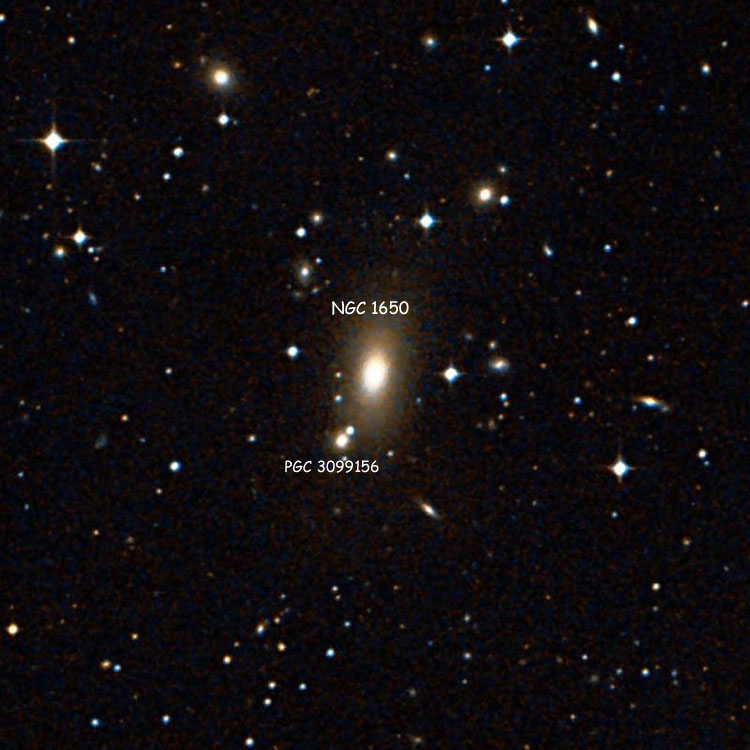
Above, a 12 arcmin wide DSS image centered on NGC 1650, also showing PGC 3099156
Below, a 2.4 arcmin wide DSS image of the galaxy, also showing PGC 3099156
Below, a 2.4 arcmin wide PanSTARRS image of the galaxy, also showing PGC 3099156
PGC 3099156
Not an NGC object but listed here since a possible companion of NGC 1650
A magnitude 16(?) lenticular galaxy (type E/S0?) in Eridanus (RA 04 45 13.7, Dec -15 53 16)
Physical Information: Given similar recessional velocity, PGC 3099156 is certainly in the same region of space as NGC 1650; but whether it is close enough to it to be a physical companion is not known, as there is no obvious interaction between them. Vr 10385 km/sec; z = 0.034634, redshift-independent distance = 35.94 Mpc. Apparent size of about 0.2 by 0.15 arcmin (from the image below).
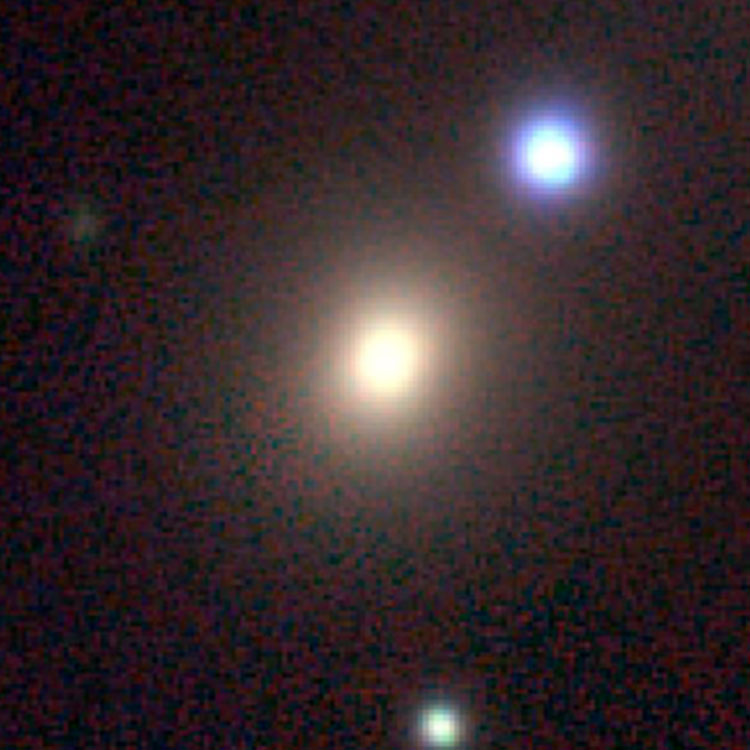
Above, a 0.75 arcmin wide PanSTARRS image of PGC 3099156; see NGC 1650 for wider-field images
NGC 1651 (= "PGC 3517898"), in the Large Magellanic Cloud
Discovered (Nov 3, 1834) by John Herschel
A magnitude 12.3 globular cluster in Mensa (RA 04 37 32.1, Dec -70 35 10)
Historical Identification: Per Dreyer, NGC 1651 (= GC 898 = JH 2662, 1860 RA 04 38 42, NPD 160 51.5) is "pretty faint, large, very little extended, very gradually a little brighter middle". Note: For purposes of completeness LEDA lists a PGC designation for this object, but a search of the database for that designation yields no result; hence its inclusion in quotes.
Physical Information:

Above, a 12 arcmin wide DSS image centered on NGC 1651
Below, a 2.4 arcmin wide DSS image of the globular cluster
*Partial HLA 'raw' image of southeastern part of cluster available*
NGC 1652 (= NGC 1649 = "PGC 3517897"), in the Large Magellanic Cloud
Discovered (Nov 2, 1834) by John Herschel (and later listed as NGC 1652)
Discovered (Dec 23, 1834) by John Herschel (and later listed as NGC 1649)
A magnitude 13.1 open cluster in Dorado (RA 04 38 22.5, Dec -68 40 21)
Historical Identification: Per Dreyer, NGC 1652 (= GC 899 = JH 2661, 1860 RA 04 38 44, NPD 158 56.4) is "very faint, small, round, gradually a little brighter middle". (Note to self: To be shown to be a duplicate of NGC 1649 in the next iteration of this page). Note: For purposes of completeness LEDA lists a PGC designation for this object, but a search of the database for that designation yields no result; hence its inclusion in quotes.
Physical Information: Given the duplicate entry, see NGC 1649 for anything else.
NGC 1653 (= PGC 15942)
Discovered (Feb 1, 1786) by William Herschel
A magnitude 12.0 elliptical galaxy (type E0?) in Eridanus (RA 04 45 47.4, Dec -02 23 34)
Historical Identification: Per Dreyer, NGC 1653 (= GC 900 = WH II 526, 1860 RA 04 38 45, NPD 92 39.1) is "faint, considerably small, round, a little brighter middle".
Physical Information: Apparent size 1.5 by 1.5 arcmin.
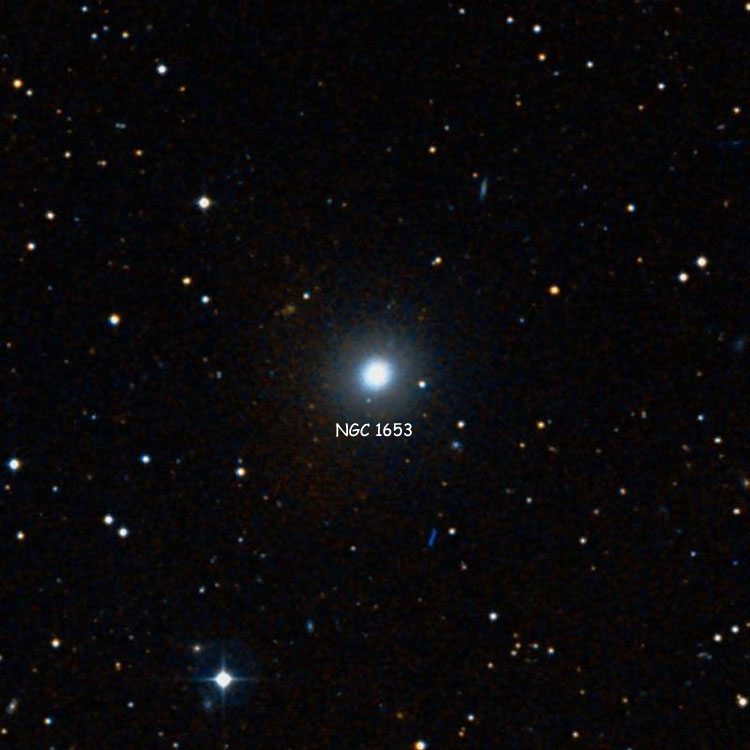
Above, a 12 arcmin wide DSS image centered on NGC 1653
Below, a 0.75 arcmin wide PanSTARRS image of the galaxy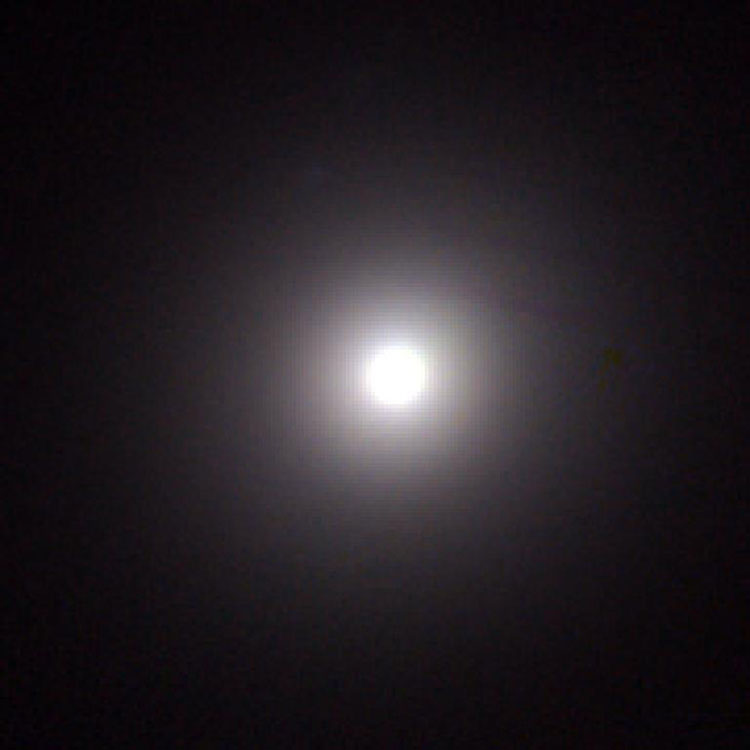
NGC 1654 (= PGC 15943)
Discovered (Dec 21, 1881) by �douard Stephan
A magnitude 13.4 spiral galaxy (type SAB(s)ab?) in Eridanus (RA 04 45 48.5, Dec -02 05 02)
Historical Identification: Per Dreyer, NGC 1654 (Stephan list XII (#33), 1860 RA 04 38 45, NPD 92 20.5) is "faint, small, round, a little brighter middle, mottled but not resolved? western of 2", the other being NGC 1657.
Physical Information: Apparent size 0.8 by 0.8 arcmin.

Above, a 12 arcmin wide DSS image centered on NGC 1654, also showing NGC 1657
Below, a 0.8 arcmin wide PanSTARRS image of the galaxy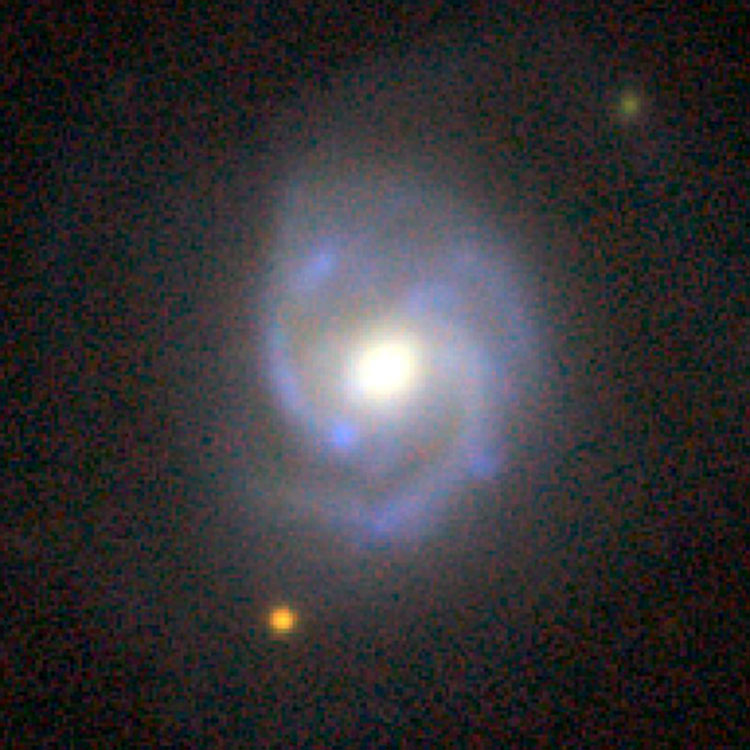
NGC 1655 (= "PGC 5067736")
Recorded (1886) by Gerhard Lohse
Also recorded (October, 1899?) by DeLisle Stewart
A lost or nonexistent object in Taurus (RA 04 47 12.3, Dec +20 55 25)
Historical Identification: Per Dreyer, NGC 1655 (J. G. Lohse, 1860 RA 04 38 55, NPD 69 20.0) is "pretty bright, round, gradually brighter middle, 10th magnitude star to south". The second IC notes (per DeLisle Stewart) "Not seen, but a hazy star 1 minute west, same declination" (this observation from plate 4053, a one-hour exposure probably taken in mid to late October). The position precesses to RA 04 47 12.3, Dec +20 55 25, almost dead center on a magnitude 16.6 star, and just north of a pair of magnitude 15.8 stars, but though there is a 10th magnitude star to the south of Lohse's position, there is nothing that matches his description anywhere in the vicinity (and per Corwin, there is nothing at the supposed position of Stewart's object, so it may be a plate defect), and NGC 1655 is either lost or nonexistent. Note: For purposes of completeness LEDA lists a PGC designation for this object, but a search of the database for that designation yields no result; hence its inclusion in quotes.
Discovery Notes: Per Corwin, Lohse sent Dreyer a list of his observations by private communication, so there is no historical reference available.
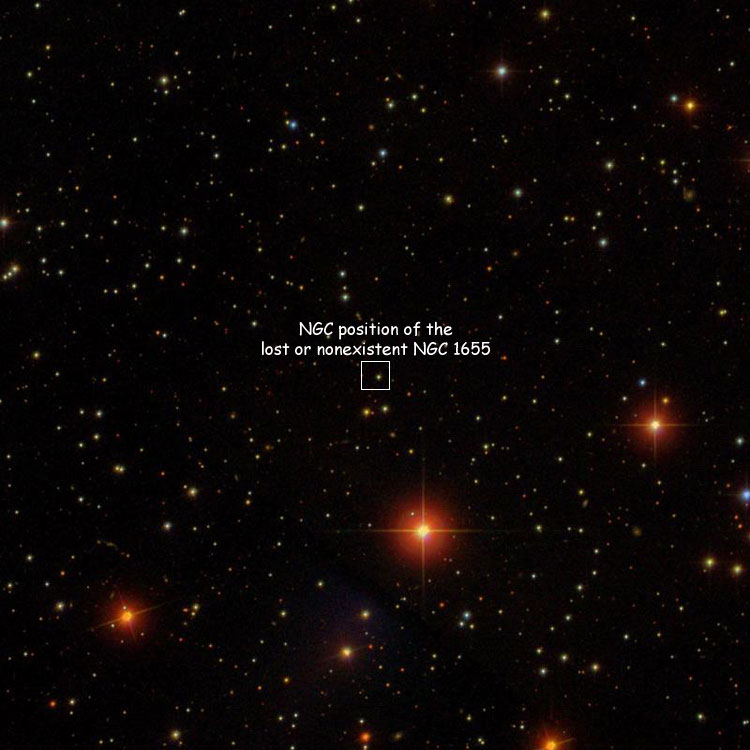
Above, a 12 arcmin wide SDSS image centered on the NGC position for NGC 1655
NGC 1656 (= PGC 15949)
Discovered (Feb 10, 1830) by John Herschel
Also observed (1877) by John Dreyer
Also observed (Feb 17, 1903) by Isaac Roberts
A magnitude 12.9 lenticular galaxy (type S0/a?) in Eridanus (RA 04 45 53.4, Dec -05 08 12)
Historical Identification: Per Dreyer, NGC 1656 (= GC 901 = JH 330, 1860 RA 04 39 01, NPD 95 23.4) is "extremely faint, irregular figure?". The second IC adds "Large, stellar nucleus in faint nebula extended northwest-southeast (per Roberts). (I found it faint, very small, round, in 1877.)"
Physical Information: Apparent size 1.5 by 1.0 arcmin.
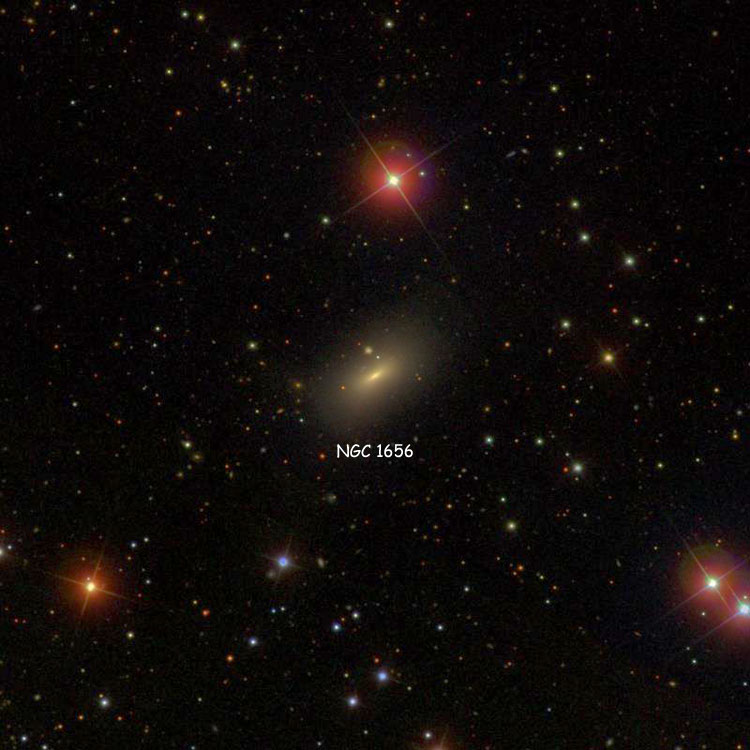
Above, a 12 arcmin wide SDSS image centered on NGC 1656
Below, a 2.4 arcmin wide SDSS image of the galaxy
NGC 1657 (= PGC 15958)
Discovered (Dec 21, 1881) by �douard Stephan
A magnitude 13.8 spiral galaxy (type SBbc?) in Eridanus (RA 04 46 07.3, Dec -02 04 38)
Historical Identification: Per Dreyer, NGC 1657 (Stephan list XII (#34), 1860 RA 04 39 04, NPD 92 20.0) is "fainter but larger than preceding (western) one", the preceding one being NGC 1654.
Physical Information: Apparent size 1.2 by 0.8 arcmin.

Above, a 12 arcmin wide DSS image centered on NGC 1657, also showing NGC 1654
Below, a 1.4 arcmin wide PanSTARRS image of the galaxy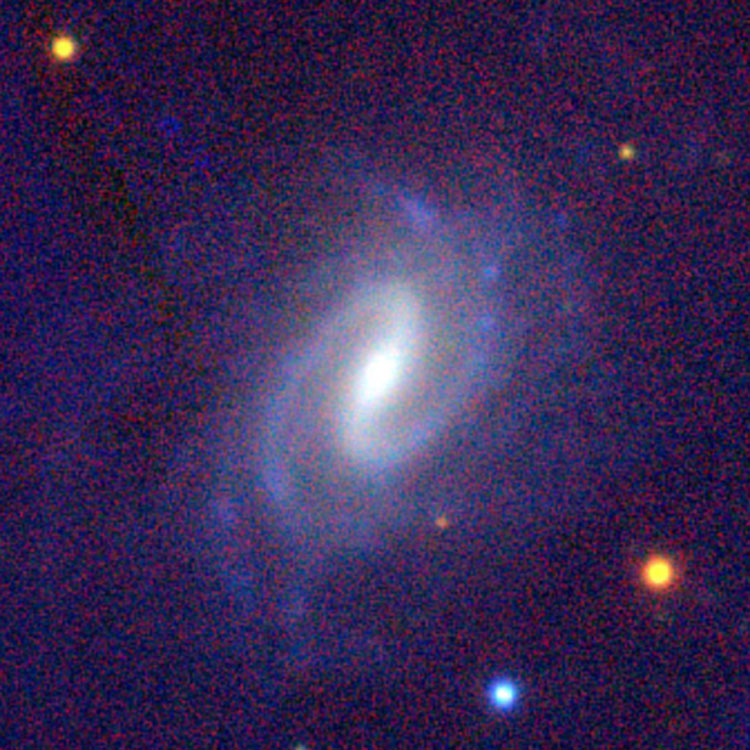
NGC 1658 (= PGC 15899)
Discovered (Dec 1, 1837) by John Herschel
A magnitude 13.5 spiral galaxy (type Sbc?) in Caelum (RA 04 44 01.4, Dec -41 27 48)
Historical Identification: Per Dreyer, NGC 1658 (= GC 902 = JH 2658, 1860 RA 04 39 29, NPD 131 45.1) is "faint, pretty small, pretty much extended, gradually a little brighter middle".
Physical Information: Apparent size 1.5 by 0.5 arcmin.

Above, a 12 arcmin wide DSS image centered on NGC 1658, also showing NGC 1660
Below, a 1.75 arcmin wide DSS image of the galaxy
NGC 1659 (= NGC 1677 = PGC 15977)
Discovered (Nov 28, 1786) by William Herschel (and later listed as NGC 1659)
Also observed (Feb 11, 1830) by John Herschel (and later listed as NGC 1659)
Discovered (Oct 22, 1886) by Lewis Swift (and later listed as NGC 1677)
A magnitude 12.5 spiral galaxy (type S(rs)bc? pec) in Eridanus (RA 04 46 30.0, Dec -04 47 20)
Historical Identification: Per Dreyer, NGC 1659 (= GC 903 = JH 331 = WH III 589, 1860 RA 04 39 35, NPD 95 02.6) is "pretty faint, pretty small, irregularly extended 90��, brighter middle".
Physical Information: Apparent size 1.5 by 1.1 arcmin.
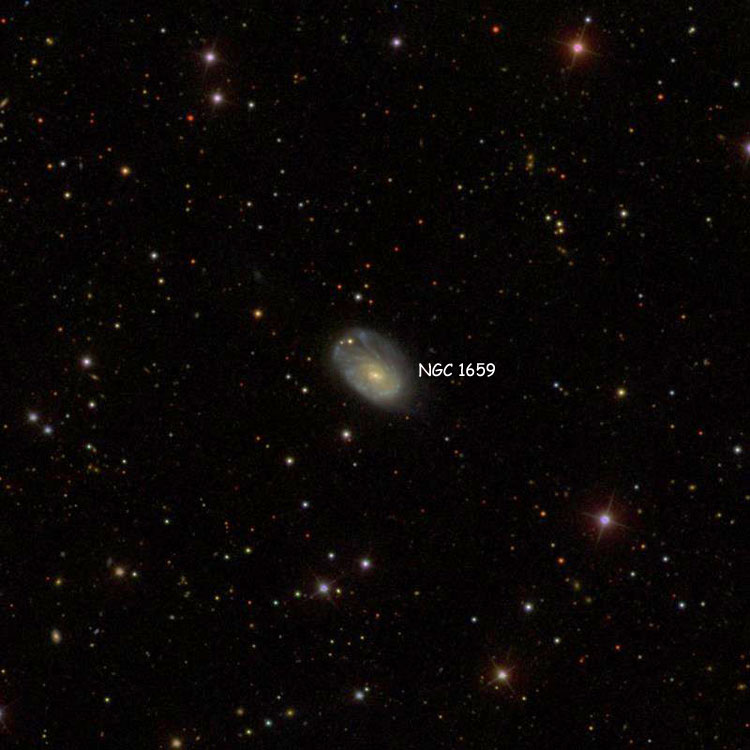
Above, a 12 arcmin wide SDSS image centered on NGC 1659
Below, a 1.6 arcmin wide SDSS image of the galaxy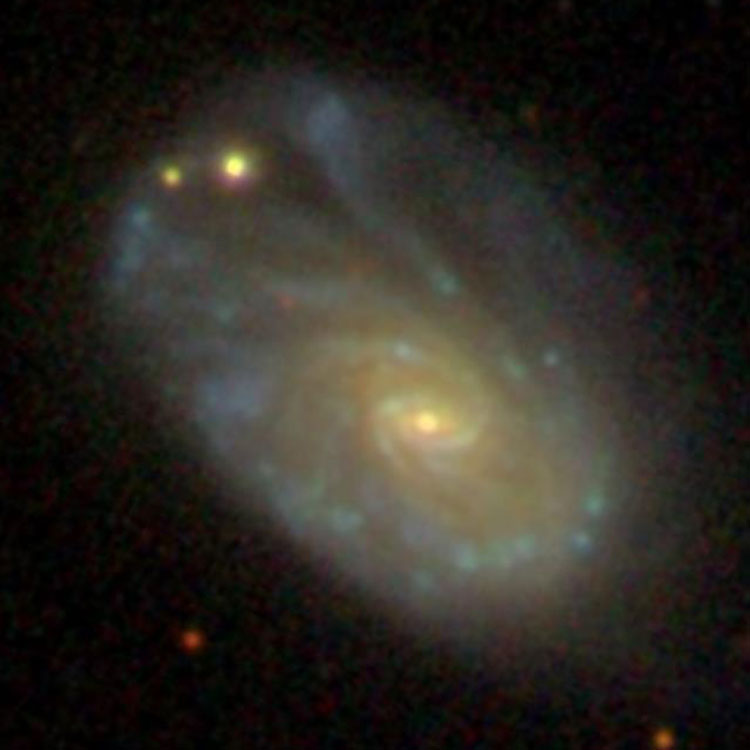
NGC 1660 (= PGC 15908)
Discovered (Dec 1, 1837) by John Herschel
A magnitude 14.0 spiral galaxy (type Sa? pec) in Caelum (RA 04 44 11.4, Dec -41 29 52)
Historical Identification: Per Dreyer, NGC 1660 (= GC 904 = JH 2659, 1860 RA 04 39 38, NPD 131 46.9) is "very faint, small, a little extended, gradually a little brighter middle".
Physical Information: Apparent size 1.0 by 0.5 arcmin.
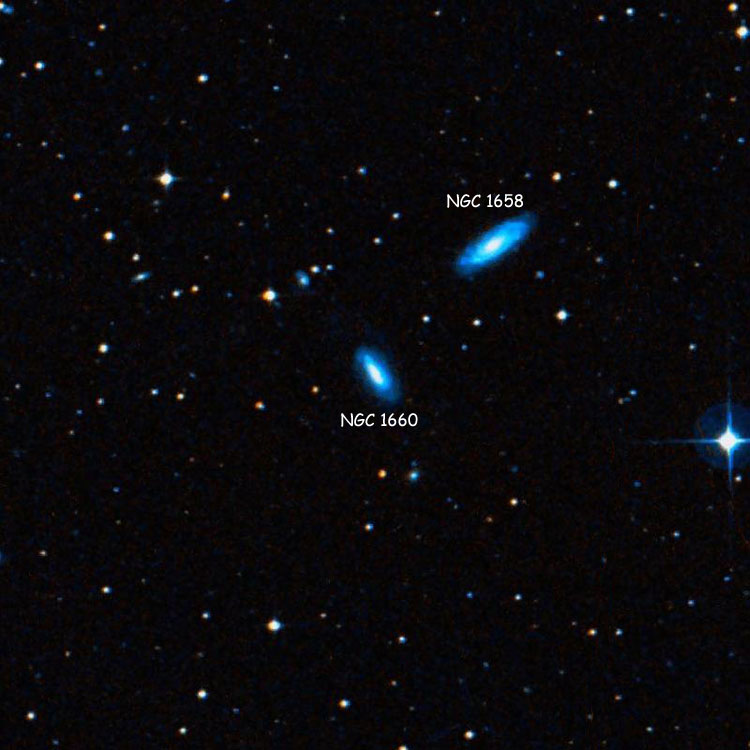
Above, a 12 arcmin wide DSS image centered on NGC 1660, also showing NGC 1658
Below, a 1.5 arcmin wide DSS image of the galaxy
NGC 1661 (= PGC 16000)
Discovered (Dec 21, 1881) by �douard Stephan
A magnitude 13.2 spiral galaxy (type SA(rs)bc? pec) in Orion (RA 04 47 07.6, Dec -02 03 16)
Historical Identification: Per Dreyer, NGC 1661 (Stephan list XII (#35), 1860 RA 04 40 05, NPD 92 18.5) is "very faint, very small, brighter middle".
Physical Information: Apparent size 1.4 by 0.9 arcmin. For a later-type spiral, has an exceptionally large, bright nucleus; perhaps a starburst galaxy?
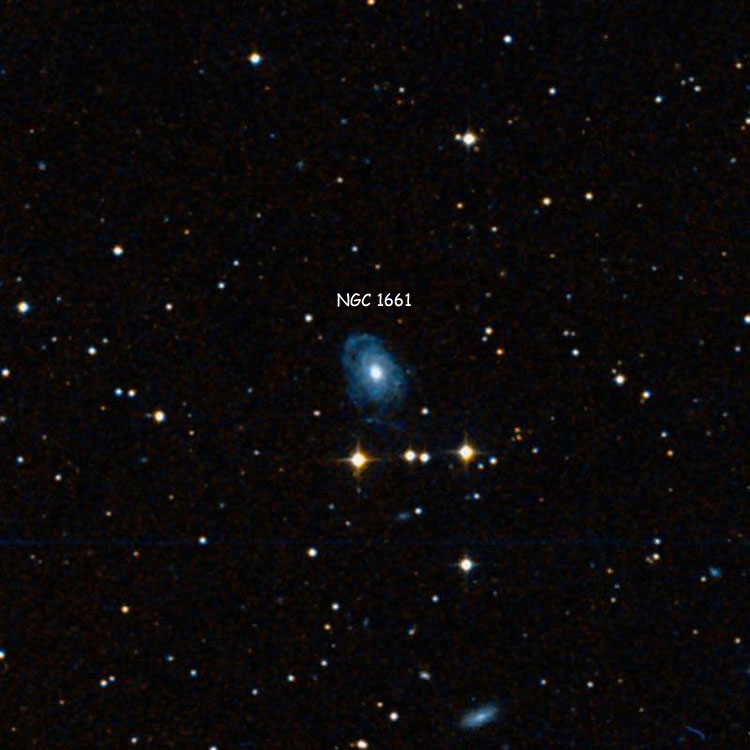
Above, a 12 arcmin wide DSS image centered on NGC 1661
Below, a 1.8 arcmin wide PanSTARRS image of the galaxy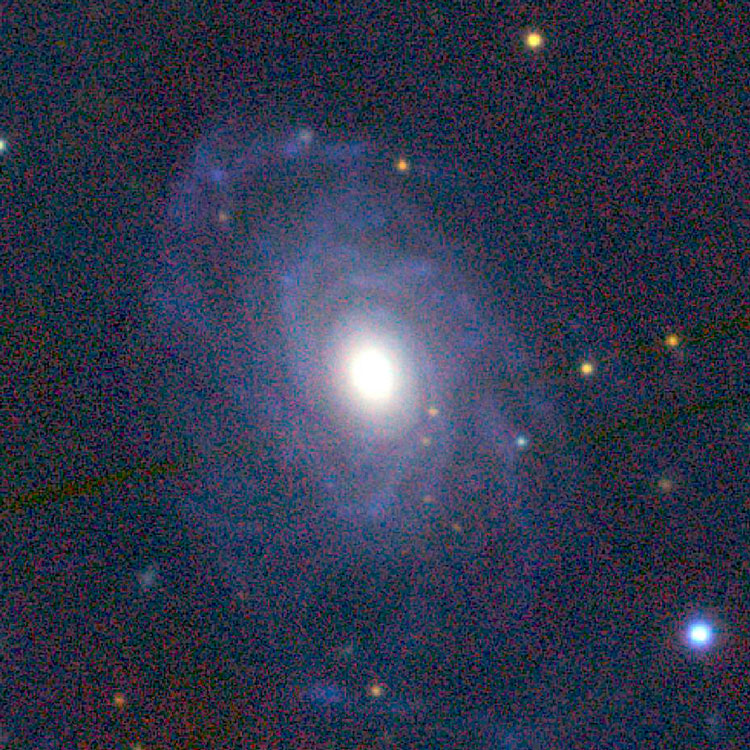
WORKING HERE: Adding pix, captions, tags, etc
NGC 1662 (= OCL 470 = "PGC 3517899")
Discovered (Jan 18, 1784) by William Herschel
Also observed (Jan 19, 1828) by John Herschel
A magnitude 6.4 open cluster (type I2p) in Orion (RA 04 48 28.0, Dec +10 55 48)
Historical Identification: Per Dreyer, NGC 1662 (= GC 905 = JH 332 = WH VII 1, 1860 RA 04 40 45, NPD 79 19.3) is "a cluster of large (bright) and small (faint) scattered stars". For purposes of completeness LEDA lists a PGC designation for this object, but a search of the database for that designation yields no result; hence its inclusion in quotes.
Physical Information: Apparent size 12 arcmin.
NGC 1663 (= OCL 461 = "PGC 3517900")
Discovered (Feb 10, 1784) by William Herschel
A magnitude 14.5 open cluster (type IV2p) in Orion (RA 04 49 22.0, Dec +13 09 12)
Per Corwin, the core of the cluster is at RA 04 49 19.0, Dec +13 10 06
Historical Identification: Per Dreyer, NGC 1663 (= GC 906 = WH VIII 7, 1860 RA 04 40 45, NPD 77 06.1) is "a cluster, a little rich, stars large (bright) and small (faint)". For purposes of completeness LEDA lists a PGC designation for this object, but a search of the database for that designation yields no result; hence its inclusion in quotes.
Physical Information: Apparent size 9.0 arcmin.
NGC 1664 (= OCL 411 = "PGC 3517901")
Discovered (Oct 24, 1786) by William Herschel
A magnitude 7.6 open cluster (type III1p) in Auriga (RA 04 51 03.0, Dec +43 40 18)
Historical Identification: Per Dreyer, NGC 1664 (= GC 907 = WH VIII 59, 1860 RA 04 41 02, NPD 46 33.3) is "a cluster, a little rich, a little compressed, pretty large". For purposes of completeness LEDA lists a PGC designation for this object, but a search of the database for that designation yields no result; hence its inclusion in quotes.
Physical Information: Apparent size 18 arcmin.
NGC 1665 (= PGC 16044)
Discovered (Oct 5, 1785) by William Herschel
Also observed (Feb 11, 1830) by John Herschel
A magnitude 12.8 lenticular galaxy (type S0?) in Eridanus (RA 04 48 17.1, Dec -05 25 39)
Historical Identification: Per Dreyer, NGC 1665 (= GC 908 = JH 333 = WH II 457, 1860 RA 04 41 24, NPD 95 41.2) is "extremely faint, pretty large, round, a little brighter middle".
Physical Information: Apparent size 1.8 by 1.1 arcmin.
NGC 1666 (= PGC 16057)
Discovered (Nov 1, 1886) by Lewis Swift
A magnitude 12.6 lenticular galaxy (type SB0/a?) in Eridanus (RA 04 48 32.8, Dec -06 34 12)
Historical Identification: Per Dreyer, NGC 1666 (Swift list V (#62), 1860 RA 04 41 39, NPD 96 49.1) is "very faint, pretty small, round".
Physical Information: Apparent size 1.4 by 1.1 arcmin.
NGC 1667 (= NGC 1689 = PGC 16062)
Discovered (Dec 13, 1884) by �douard Stephan (and later listed as NGC 1667)
Discovered (Oct 22, 1886) by Lewis Swift (and later listed as NGC 1689)
A magnitude 12.1 spiral galaxy (type SBc?) in Eridanus (RA 04 48 37.2, Dec -06 19 12)
Historical Identification: Per Dreyer, NGC 1667 (Stephan list XIII (#26), 1860 RA 04 41 47, NPD 96 34.2) is "pretty faint, pretty small, round, mottled but not resolved?".
Physical Information: Apparent size 1.4 by 1.0 arcmin.
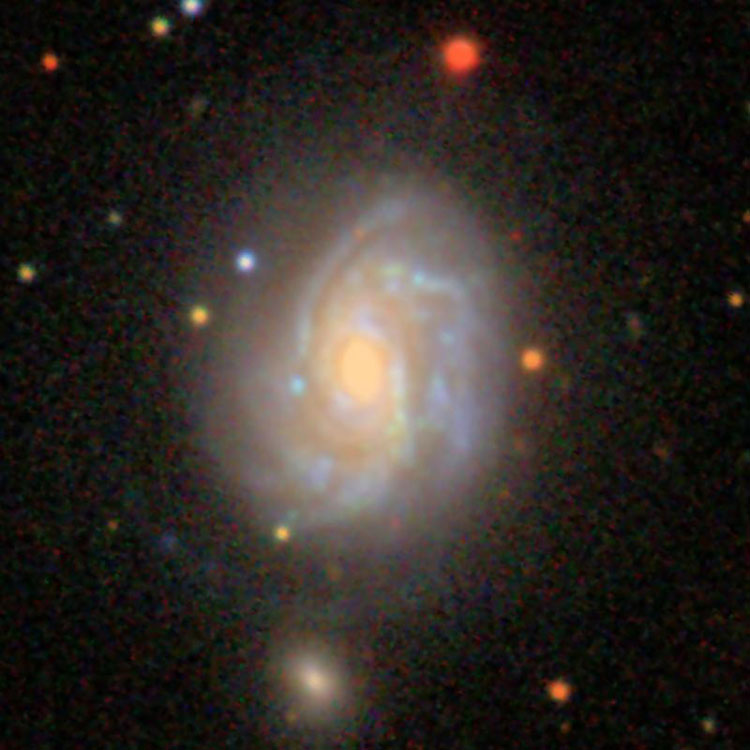
Above, a 2.4 arcmin wide closeup of NGC 1667
Below, a 12 arcmin wide region centered on the galaxy
(2MASXJ04483774-0620114 = 6dFJ0448378-062012 = "PGC 3686803")
Not an NGC object but listed here as an apparent companion of NGC 1667
A magnitude 16? spiral galaxy (type Sb?) in Eridanus (RA 04 48 37.8, Dec -06 20 12)
Physical Information: Vr 4280 km/sec
NGC 1668 (= PGC 15957)
Discovered (Dec 1, 1837) by John Herschel
A magnitude 12.8 lenticular galaxy (type E/SB0?) in Caelum (RA 04 46 05.9, Dec -44 44 00)
Historical Identification: Per Dreyer, NGC 1668 (= GC 909 = JH 2663, 1860 RA 04 42 00, NPD 135 02.1) is "extremely faint, round, attached to 14th magnitude star".
Physical Information: Apparent size 1.6 by 0.9 arcmin.
NGC 1669 (= PGC 15871 = PGC 309962)
Discovered (Dec 20, 1835) by John Herschel
A magnitude 13.8 spiral galaxy (type Sa?) in Dorado (RA 04 42 59.9, Dec -65 48 52)
Historical Identification: Per Dreyer, NGC 1669 (= GC 910 = JH 2664, 1860 RA 04 42 20, NPD 156 04.1) is "extremely faint, small, round".
Physical Information: Apparent size 0.8 by 0.4 arcmin.
NGC 1670 (= PGC 16107)
Discovered (Feb 1, 1786) by William Herschel
A magnitude 12.8 lenticular galaxy (type S0?) in Orion (RA 04 49 42.6, Dec -02 45 38)
Historical Identification: Per Dreyer, NGC 1670 (= GC 911 = WH III 501, 1860 RA 04 42 40, NPD 93 00.3) is "very faint, very small".
Physical Information: Apparent size 1.3 by 0.7 arcmin.
PGC 1083388
Not an NGC object but listed here as an apparent companion of NGC 1670
A magnitude 17(?) galaxy (type ?) in Orion (RA 04 49 37.4, Dec -02 46 03
Physical Information:
NGC 1671 (probably not = IC 395 = PGC 16095)
Recorded (Oct 20, 1886) by Lewis Swift
A lost or nonexistent object in Orion (RA 4 50 16.5, Dec -00 46 12)
or a magnitude 12.9 lenticular galaxy (type SB0?) at RA 04 49 34.0, Dec +00 15 10
Historical Identification: Per Dreyer, NGC 1671 (Swift list V (#63), 1860 RA 04 43 09, NPD 91 00.9) is "pretty faint, pretty small, round" (Swift's Catalogue No. 5 note adds "pretty bright star near to southwest"). The position precesses to RA 04 50 16.5, Dec -00 46 12 (whence the position above), but there is nothing there, nor anywhere near there. Corwin states that whatever Swift thought he saw is probably lost or nonexistent, but mentions the possibility that NGC 1671 might be the same as IC 395, then rejects the idea because it would require a huge error in position (43 seconds of time in right ascension, and more than a degree in declination) that cannot be explained in any reasonable way. However, the description of NGC 1671 fits IC 395 as well or better than its own description, and as a somewhat surprising result the identity of the two listings has been almost universally accepted. So although I agree with Corwin's conclusion that NGC 1671 is lost or nonexistent, its possible identity with IC 395 has to be mentioned for the sake of completeness, no matter how unwillingly. (Note: Steinicke lists NGC 1671 as IC 395.)
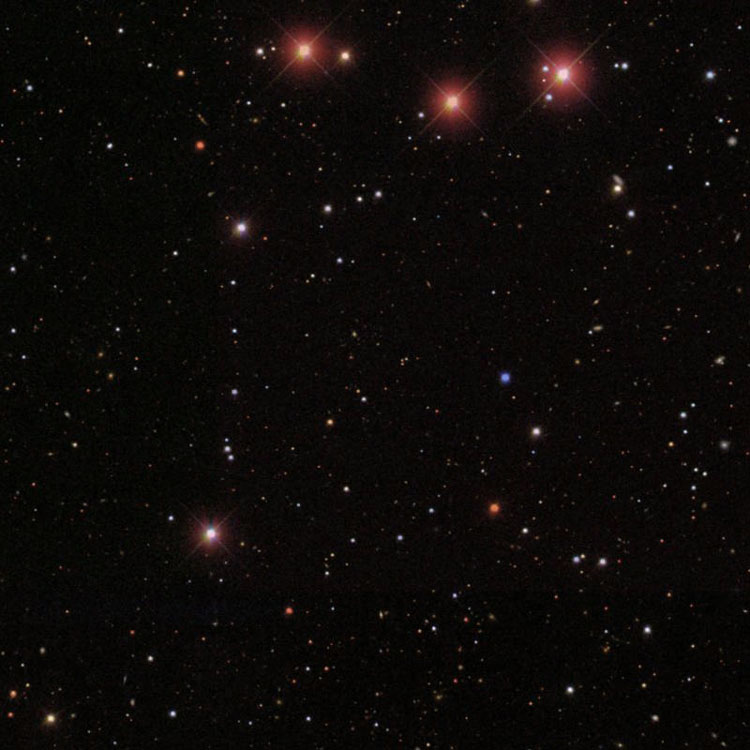
Above, a 12 arcmin wide region centered on the position of the probably nonexistent NGC 1671
NGC 1672 (= PGC 15941)
Discovered (Nov 5, 1826) by James Dunlop
Also observed (Dec 4, 1834) by John Herschel
A magnitude 9.7 spiral galaxy (type SBb?) in Dorado (RA 04 45 42.5, Dec -59 14 50)
Historical Identification: Per Dreyer, NGC 1672 (= GC 912 = JH 2665, Dunlop 296??, 1860 RA 04 43 32, NPD 149 30.1) is "bright, large, suddenly much brighter middle and nucleus". (The attribution to Dunlop 296, though very uncertain in the NGC, is now considered certain.)
Physical Information: Apparent size 6.7 by 5.6 arcmin
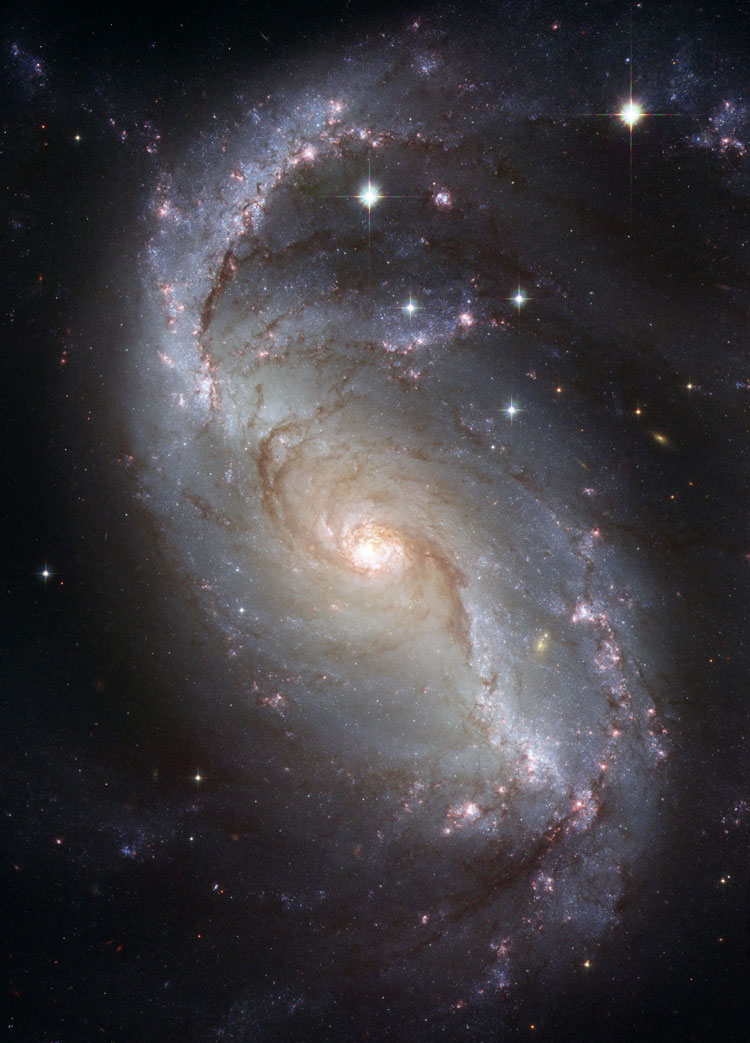
Above, a HST image of part of NGC 1672; orientation shows detail, but North is either at left or right
(Image Credit NASA, ESA, Hubble Heritage Team (STScI/AURA) Hubble Heritage (STScI/AURA); Acknowledgment: L. Jenkins (GSFC/U. Leicester) )
Need to add this image ASAP
NGC 1673 (= "PGC 3517902"), in the Large Magellanic Cloud
Discovered (Dec 23, 1834) by John Herschel
A magnitude 14.1 open cluster in Mensa (RA 04 42 39.8, Dec -69 49 10)
Historical Identification: Per Dreyer, NGC 1673 (= GC 913 = JH 2667, 1860 RA 04 43 35, NPD 160 04.0) is "very faint, small, attached to 10th magnitude star". For purposes of completeness LEDA lists a PGC designation for this object, but a search of the database for that designation yields no result; hence its inclusion in quotes.
Physical Information: Apparent size 0.70 arcmin.
NGC 1674 (= "PGC 5067695"; associated with NGC 1675)
Recorded (1886) by Gerhard Lohse
A lost object or part of a group of stars in Taurus (RA 04 52 24.7, Dec +23 51 11)
Historical Identification: Per Dreyer, NGC 1674 and 1675 (J. G. Lohse, 1860 RA 04 43 56, NPD 66 20.0) are "two faint nebulae in the same field". Lohse identified this as one of two faint nebulae in Taurus, the other being listed as NGC 1675. Nothing exists at Lohse's recorded position, and the nebulae should probably be considered lost or nonexistent. However, there is a tentative identification of a small stellar group at the position listed above as something that might correspond to Lohse's observation. If that is correct, then the single group would correspond to both of Lohse's nebulae, given the identical position listed for the two NGC objects. For purposes of completeness LEDA lists a PGC designation for this object, but a search of the database for that designation yields no result; hence its inclusion in quotes.
NGC 1675 (= "PGC 5067695"; associated with NGC 1674)
Recorded (1886) by Gerhard Lohse
A lost object or part of a group of stars in Taurus (RA 04 52 24.7, Dec +23 51 11)
Historical Identification: Per Dreyer, NGC 1674 and 1675 (J. G. Lohse, 1860 RA 04 43 56, NPD 66 20.0) are "two faint nebulae in the same field". Lohse identified this as one of two faint nebulae in Taurus, the other being listed as NGC 1674. Nothing exists at Lohse's recorded position, and the nebulae should probably be considered lost or nonexistent. However, there is a tentative identification of a small stellar group at the position listed above as something that might correspond to Lohse's observation. If that is correct, then the single group would correspond to both of Lohse's nebulae, given the identical position listed for the two NGC objects. A search of LEDA for NGC 1675 returns no result, but since it is thought to be the same as NGC 1674, I have listed the same PGC designation (for purposes of completeness LEDA lists a PGC designation for that object, but a search of the database for that designation yields no result; hence its inclusion in quotes).
NGC 1676 (= "PGC 3517903"), in the Large Magellanic Cloud)
Discovered (Dec 13, 1835) by John Herschel
An open cluster in Dorado (RA 04 43 53.8, Dec -68 49 39)
Historical Information: Per Dreyer, NGC 1676 (= GC 914 = JH 2669, 1860 RA 04 44 19, NPD 159 04.5) is "very faint, pretty large, irregularly round, mottled but not resolved". The position precesses to RA 04 43 49.5, Dec -68 49 17, on the northwestern rim of the apparently loose group of stars listed above (though since the cluster is in the LMC, it may have far more members than it appears at first glance), the description fits and there is nothing comparable nearby, so the identification is certain. For purposes of completeness LEDA lists a PGC designation for this object, but a search of the database for that designation yields no result; hence its inclusion in quotes.
Note About the Position: In modern photographs the core of the physical cluster lies almost a second of time to the west of the position shown above, but Herschel would have seen the cluster as not only the central grouping but also the oval of somewhat brighter stars surrounding that, so the NGC "object" is centered a little to the east of the core of the LMC cluster.
Physical Information Apparent size of about 1.05 by 0.85 arcmin (from the images below).

Above, a 12 arcmin wide DSS image of NGC 1676
Below, a 2 arcmin wide DSS image of the cluster
NGC 1677 (= NGC 1659 = PGC 15977)
Discovered (Nov 28, 1786) by William Herschel (and later listed as NGC 1659)
Also observed (Feb 11, 1830) by John Herschel (and later listed as NGC 1659)
Discovered (Oct 22, 1886) by Lewis Swift (and later listed as NGC 1677)
A magnitude 12.5 spiral galaxy (type Sbc?) in Eridanus (RA 04 46 30.0, Dec -04 47 20)
Historical Identification: Per Dreyer, NGC 1677 (Swift list V (#64), 1860 RA 04 44 26, NPD 95 02.4) is "pretty faint, pretty large, a little extended".
Physical Information: Given the duplicate entry, see NGC 1659 for anything else.
NGC 1678 (= PGC 16179)
Discovered (Feb 1, 1786) by William Herschel
A magnitude 13.2 lenticular galaxy (type S0?) in Orion (RA 04 51 35.4, Dec -02 37 23)
Historical Identification: Per Dreyer, NGC 1678 (= GC 915 = WH III 502, 1860 RA 04 44 32, NPD 92 52.0) is "very faint, small".
Physical Information: Apparent size 1.1 by 0.8 arcmin.
PGC 16180
Not an NGC object but listed here as an apparent companion of NGC 1678
A magnitude 14(?) spiral galaxy (type Sb?) in Orion (RA 04 51 36.3, Dec -02 33 37)
Physical Information:
PGC 1087632
Not an NGC object but listed here as an apparent companion of NGC 1678
A magnitude 15.5(?) lenticular galaxy (type S0/a?) in Orion (RA 04 51 43.3, Dec -02 35 51)
Physical Information:
NGC 1679 (= PGC 16120)
Discovered (Nov 18, 1835) by John Herschel
A magnitude 11.6 spiral galaxy (type SBm?) in Caelum (RA 04 49 55.2, Dec -31 57 59)
Historical Identification: Per Dreyer, NGC 1679 (= GC 916 = JH 2666, 1860 RA 04 44 39, NPD 122 12.8) is "very bright, large, irregularly round, 4 stars involved".
Physical Information: Apparent size 2.7 by 2.0 arcmin.

Above, a 3 arcmin wide closeup of NGC 1679
Below, a 12 arcmin wide region centered on the galaxy
NGC 1680 (= PGC 16058)
Discovered (Dec 28, 1834) by John Herschel
A magnitude 13.6 spiral galaxy (type SBb?) in Pictor (RA 04 48 33.9, Dec -47 49 00)
Historical Identification: Per Dreyer, NGC 1680 (= GC 917 = JH 2668, 1860 RA 04 44 42, NPD 138 03.5) is "very faint, small, round, mottled but not resolved or star involved".
Physical Information: Apparent size 1.2 by 0.5 arcmin.
NGC 1681 (= PGC 16195)
Discovered (Jan 6, 1878) by �douard Stephan
A magnitude 12.9 spiral galaxy (type Sb?) in Eridanus (RA 04 51 50.1, Dec -05 48 12)
Historical Identification: Per Dreyer, NGC 1681 (Stephan list IX (#4), 1860 RA 04 44 58, NPD 96 02.6) is "very faint, small, round, very little brighter middle".
Physical Information: Apparent size 1.3 by 1.2 arcmin.
NGC 1682 (= PGC 16211)
Discovered (Feb 1, 1786) by William Herschel
Also observed (Dec 3, 1861) by Heinrich d'Arrest
A magnitude 13.5 lenticular galaxy (type E/SA0? pec) in Orion (RA 04 52 19.8, Dec -03 06 21)
Historical Identification: Per Dreyer, NGC 1682 (= GC 919, WH II 527, d'Arrest, 1860 RA 04 45 20, NPD 93 20.7) is "very faint, very small, II 528 twelve seconds� of time to east, 9th magnitude star 4.5 arcmin to south", (WH) II 528 being NGC 1684.
Physical Information: Apparent size 0.9 by 0.9 arcmin. Recessional velocity 4395 km/sec. Probably in a group with NGC 1684
NGC 1683 (= PGC 16209)
Discovered (January, 1850) by George Stoney
A magnitude 14.7 spiral galaxy (type Sa? pec) in Orion (RA 04 52 17.6, Dec -03 01 28)
Historical Identification: Per Dreyer, NGC 1683 (= GC 918, 3rd Lord Rosse, 1860 RA 04 45 24, NPD 93 15.8) is "very faint, round".
Discovery Notes: Although Dreyer credits the discovery to William Parsons, 3rd Earl of Rosse, he notes that many of Rosse's nebular discoveries were actually made by one of his assistants, in this case George Stoney.
Physical Information: Apparent size 1.0 by 0.4 arcmin. Recessional velocity 3990 km/sec. Possibly in a group with NGC 1682 and 1684.
NGC 1684 (= PGC 16219 + J2000 045230.8-030622)
Discovered (Feb 1, 1786) by William Herschel
Also observed (Nov 24, 1827) by John Herschel
Also observed (Dec 26, 1856) by R. J. Mitchell
A pair of galaxies in Orion
A magnitude 12.0 elliptical galaxy (type E? pec) at RA 04 52 31.1, Dec -03 06 22
A magnitude ? elliptical galaxy (type E? pec) at RA 04 52 30.8, Dec -03 06 22
Historical Identification: Per Dreyer, NGC 1684 (= GC 920 = GC 921 = GC 924 = JH 334 = WH II 528, 1860 RA 04 45 32, NPD 93 20.7) is "pretty faint, pretty small, round, brighter middle, 9th magnitude star at position angle 225��".
Physical Information: A pair of elliptical galaxies, interacting with each other (as shown by the dust lanes apparent in the PanSTARRS and HST images below). Apparent size 2.2 by 1.7 arcmin?? Recessional velocity 4425 km/sec. Probably in a group with NGC 1682.
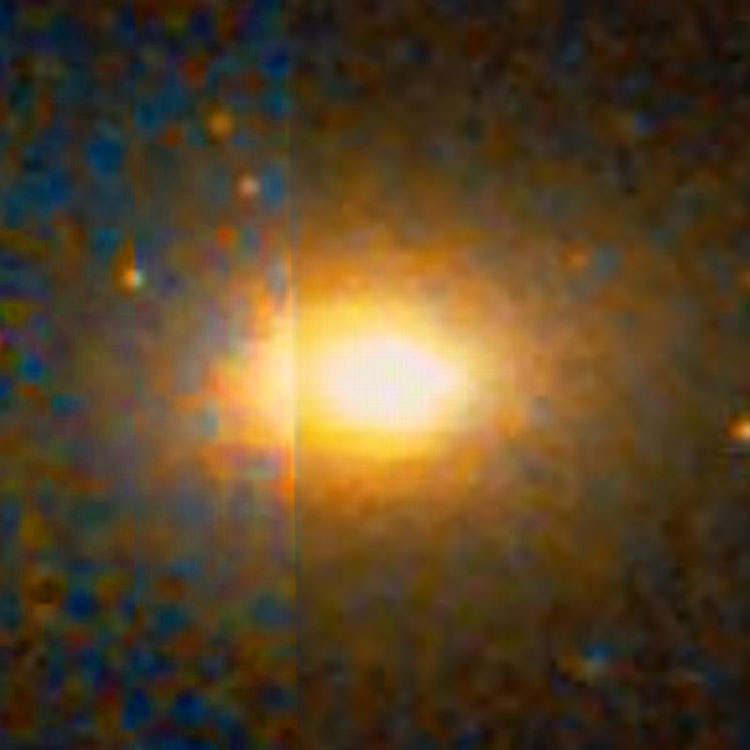
Above, a 2.4 arcmin wide closeup of NGC 1684
Below, a 12 arcmin wide region centered on the galaxy, also showing NGC 1682 and 1683
To be added: A PanSTARRS image, and two HST (HLA) images
NGC 1685 (= PGC 16222)
Discovered (January, 1850) by George Stoney
A magnitude 14.1 lenticular galaxy (type SB0/a?) in Orion (RA 04 52 34.3, Dec -02 56 57)
Historical Identification: Per Dreyer, NGC 1685 (= GC 922, 3rd Lord Rosse, 1860 RA 04 45 38, NPD 93 08.7) is "faint".
Discovery Notes: Although Dreyer credits the discovery to William Parsons, 3rd Earl of Rosse, he notes that many of Rosse's nebular discoveries were actually made by one of his assistants, in this case George Stoney.
Physical Information: Apparent size 1.3 by 0.9 arcmin.
NGC 1686 (= PGC 16239)
Discovered (Dec 26, 1885) by Francis Leavenworth
Also observed (Jul 1899 to Jun 1900) by Herbert Howe
A magnitude 13.7 spiral galaxy (type Sbc?) in Eridanus (RA 04 52 54.6, Dec -15 20 47)
Historical Identification: Per Dreyer, NGC 1686 (Leavenworth list I (#138), 1860 RA 04 45 40, NPD 105 35.2) is "extremely faint, very small, much extended 30�". The second IC lists a corrected 1860 RA (per Howe) of 04 46 34 (and a Decliation of (1900) -15 30.6).
Physical Information: Apparent size 1.7 by 0.3 arcmin.
NGC 1687 (= PGC 16166)
Discovered (Jan 8, 1836) by John Herschel
A magnitude 13.9 spiral galaxy (type SBab?) in Caelum (RA 04 51 21.4, Dec -33 56 20)
Historical Identification: Per Dreyer, NGC 1687 (= GC 923 = JH 2670, 1860 RA 04 46 09, NPD 124 10.4) is "very faint, small, round, very gradually a little brighter middle".
Physical Information: Apparent size 1.3 by 0.5 arcmin.
NGC 1688 (= PGC 16050)
Discovered (Dec 4, 1834) by John Herschel
A magnitude 12.1 spiral galaxy (type SBc?) in Dorado (RA 04 48 23.8, Dec -59 48 01)
Historical Identification: Per Dreyer, NGC 1688 (= GC 925 = JH 2671, 1860 RA 04 46 19, NPD 150 02.1) is "pretty bright, pretty large, irregularly round, pretty gradually much brighter middle".
Physical Information: Apparent size 2.4 by 1.9 arcmin.

Above, a 3 arcmin wide closeup of NGC 1688
Below, a 12 arcmin wide region centered on the galaxy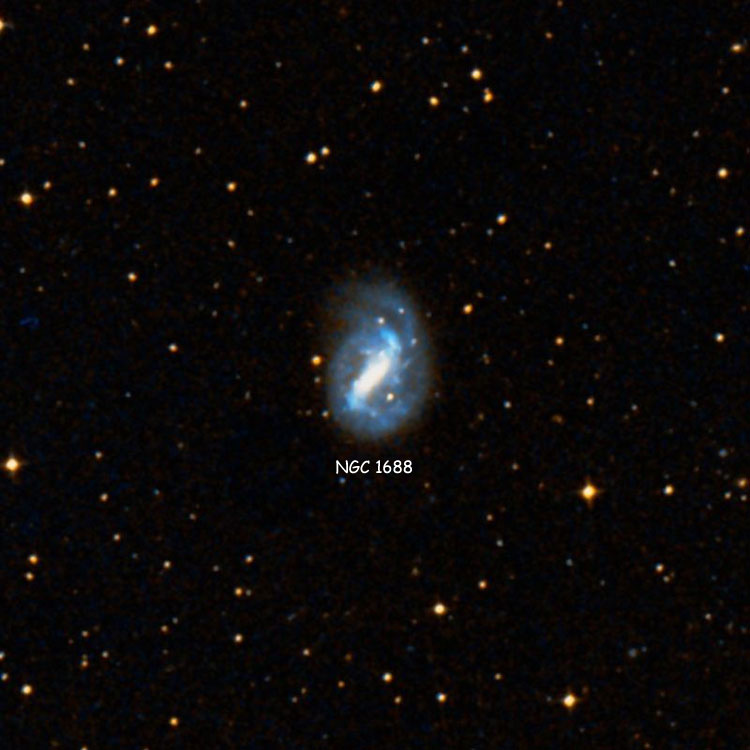
NGC 1689 (= NGC 1667 = PGC 16062)
Discovered (Dec 13, 1884) by �douard Stephan (and later listed as NGC 1667)
Discovered (Oct 22, 1886) by Lewis Swift (and later listed as NGC 1689)
Also looked for but not found (Jan to Jun 1898) by Herbert Howe (while listed as NGC 1689)
A magnitude 12.1 spiral galaxy (type SBc?) in Eridanus (RA 04 48 37.2, Dec -06 19 12)
Historical Identification: Per Dreyer, NGC 1689 (Swift list V (#65), 1860 RA 04 46 47, NPD 96 33.9) is "pretty bright, pretty small, a little extended". The second IC adds "Not found by Howe. Perhaps equal to 1667." (Although Howe did not find NGC 1689, he suggested that it might be NGC 1667, with an error of 5 minutes in the RA, as that object had the same declination. So as of this date, the suggestion of the duplicate entry is over 130 years old.)
Physical Information: Given the duplicate entry, see NGC 1667 for anything else see.
NGC 1690 (= PGC 16290)
Discovered (Feb 5, 1831) by John Herschel
A magnitude 14.3 elliptical galaxy (type E?) in Orion (RA 04 54 19.3, Dec +01 38 25)
Historical Identification: Per Dreyer, NGC 1690 (= GC 926 = JH 335, 1860 RA 04 47 06, NPD 88 35.8) is "very faint, very small, among very small (faint) stars, large (bright) star to southwest".
Physical Information: Apparent size 1.0 by 1.0 arcmin.
PGC 16289
Not an NGC object but listed here as an apparent companion to NGC 1690
A magnitude 14.5(?) spiral galaxy (type SBab?) in Orion (RA 04 54 16.6, Dec +01 40 03)
Physical Information: The lack of star-forming regions makes the images look more like a barred lenticular galaxy than a typical spiral, but the extended spiral arms and considerable amount of dust in those arms would make it a very peculiar lenticular.
NGC 1691 (= PGC 16300)
Discovered (Dec 15, 1876) by �douard Stephan
A magnitude 12.0 lenticular galaxy (type SB0/a?) in Orion (RA 04 54 38.4, Dec +03 16 05)
Historical Identification: Per Dreyer, NGC 1691 (= GC 5346, Stephan list VIII (#16), 1860 RA 04 47 19, NPD 86 57.8) is "faint, small, 11th magnitude star involved".
Physical Information: Apparent size 2.3 by 1.8 arcmin.
NGC 1692 (= PGC 16336)
Discovered (Dec 11, 1885) by Ormond Stone
A magnitude 13.0 lenticular galaxy (type S0?) in Eridanus (RA 04 55 23.7, Dec -20 34 16)
Historical Identification: Per Dreyer, NGC 1692 (Ormond Stone list I (#139), 1860 RA 04 47 40, NPD 110 47.1) is "extremely faint, very small, round".
Physical Information: Apparent size 1.3 by 1.2 arcmin.
PGC 840050
Not an NGC object but listed here as an apparent companion to NGC 1692
A magnitude 15(?) lenticular galaxy (type S0?) in Eridanus (RA 04 55 26.1, Dec -20 33 20)
Physical Information:
PGC 16337
Not an NGC object but listed here as an apparent companion to NGC 1692
A magnitude 15(?) spiral galaxy (type Sc? pec) in Eridanus (RA 04 55 26.4, Dec -20 35 07)
Physical Information:
NGC 1693 (= "PGC 3517904"), in the Large Magellanic Cloud
Discovered (Nov 3, 1834) by John Herschel
A magnitude 12.9 open cluster in Dorado (RA 04 47 39.6, Dec -69 20 38)
Historical Identification: Per Dreyer, NGC 1693 (= GC 927 = JH 2672, 1860 RA 04 48 23, NPD 159 35.2) is "faint, small, round". For purposes of completeness LEDA lists a PGC designation for this object, but a search of the database for that designation yields no result; hence its inclusion in quotes.
Physical Information: Apparent size 0.7 arcmin.
NGC 1694 (= PGC 16335)
Discovered (Jan 9, 1880) by �douard Stephan
A magnitude 14.3 spiral galaxy (type Sc?) in Eridanus (RA 04 55 16.8, Dec -04 39 09)
Historical Identification: Per Dreyer, NGC 1694 (Stephan list X (#18), 1860 RA 04 48 23, NPD 94 52.8) is "very faint, very small, round, suddenly brighter middle".
Physical Information: Apparent size 1.2 by 0.7 arcmin.
NGC 1695 (= "PGC 3517905"), in the Large Magellanic Cloud)
Discovered (Nov 3, 1834) by John Herschel
A magnitude 12.2 open cluster in Dorado (RA 04 47 44.5, Dec -69 22 26)
Historical Identification: Per Dreyer, NGC 1695 (= GC 928 = JH 2673, 1860 RA 04 48 30, NPD 159 37.1) is "faint, small, round". For purposes of completeness LEDA lists a PGC designation for this object, but a search of the database for that designation yields no result; hence its inclusion in quotes.
Physical Information: Apparent size 1.5 arcmin.
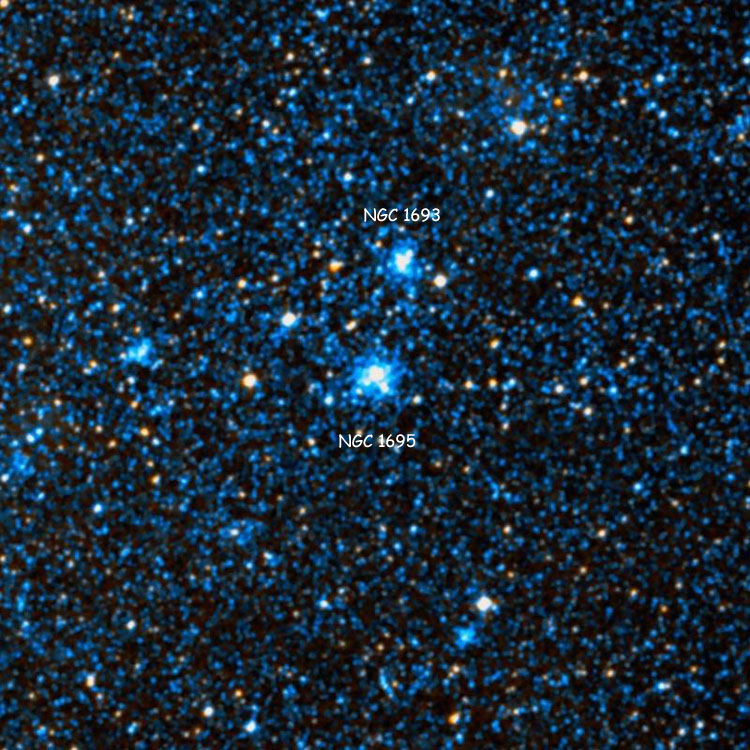
Above, a 12 arcmin wide DSS image centered on NGC 1695, also showing NGC 1693
Below, a 2 arcmin wide DSS image of the open cluster
NGC 1696 (= "PGC 3517906"), in the Large Magellanic Cloud
Discovered (Nov 2, 1834) by John Herschel
A magnitude 14.0 open cluster in Dorado (RA 04 48 29.8, Dec -68 14 34)
Historical Identification: Per Dreyer, NGC 1696 (= GC 929, JH 2674, 1860 RA 04 48 47, NPD 158 27.4) is "very faint, extended, very little brighter middle". For purposes of completeness LEDA lists a PGC designation for this object, but a search of the database for that designation yields no result; hence its inclusion in quotes.
Physical Information: Apparent size 0.9 arcmin.
NGC 1697 (= "PGC 3517907"), in the Large Magellanic Cloud
Discovered (Nov 2, 1834) by John Herschel
A magnitude 12.6 globular cluster in Dorado (RA 04 48 36.5, Dec -68 33 38)
Historical Identification: Per Dreyer, NGC 1697 (= GC 930 = JH 2675, 1860 RA 04 49 02, NPD 158 47.5) is "a globular cluster, pretty bright, large, round, partially resolved (some stars seen)". For purposes of completeness LEDA lists a PGC designation for this object, but a search of the database for that designation yields no result; hence its inclusion in quotes.
Physical Information: Apparent size 2.6 arcmin??

Above, a 12 arcmin wide DSS image centered on NGC 1697
Below, a 2.4 arcmin wide DSS image of the globular cluster
NGC 1698 (= "PGC 3517908"), in the Large Magellanic Cloud
Discovered (Dec 23, 1834) by John Herschel
A magnitude 12.1 globular cluster in Dorado (RA 04 49 04.2, Dec -69 06 55)
Historical Identification: Per Dreyer, NGC 1698 (= GC 931 = JH 2677, 1860 RA 04 49 42, NPD 159 20.7) is "pretty bright, pretty small, round, gradually a little brighter middle". For purposes of completeness LEDA lists a PGC designation for this object, but a search of the database for that designation yields no result; hence its inclusion in quotes.
Physical Information: Apparent size 1.6 arcmin.

Above, a 12 arcmin wide DSS image centered on NGC 1698
Below, a 2 arcmin wide DSS image of the globular cluster
NGC 1699 (= PGC 16390)
Discovered (Feb 13, 1860) by Samuel Hunter
Also observed (Dec 22, 1886) by Lewis Swift
A magnitude 13.9 spiral galaxy (type Sb?) in Eridanus (RA 04 56 59.6, Dec -04 45 25)
Historical Identification: Per Dreyer, NGC 1699 (3rd Lord Rosse, Swift list VI (#21), 1860 RA 04 50 01, NPD 94 58.8) is "most extremely faint, pretty small, round, between 2 stars, north of 932", (JH) 932 being NGC 1700.
Discovery Notes: Although Dreyer credits the discovery to William Parsons, 3rd Earl of Rosse, he notes that many of Rosse's nebular discoveries were actually made by one of his assistants, in this case Samuel Hunter.
Physical Information: Apparent size 0.9 by 0.5 arcmin.

Above, a 2.4 arcmin wide closeup of NGC 1699
Below, a 12 arcmin wide region centered on the galaxy, also showing part of NGC 1700